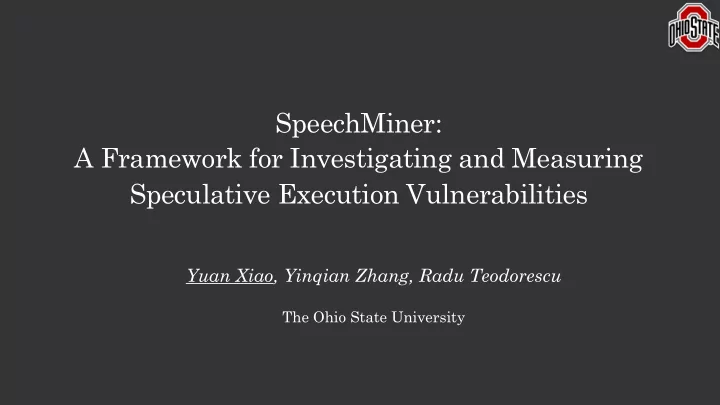

SpeechMiner: A Framework for Investigating and Measuring Speculative Execution Vulnerabilities Yuan Xiao, Yinqian Zhang, Radu Teodorescu The Ohio State University
SPEculative Execution side Channel Hardware (SPEECH) Vulnerabilities Leverage transient execution on modern x86 processors to leak • secret data whose access is forbidden Speculatively executes instructions Execution leaves trace in cache Execution results discarded Secrets inferred by cache side channel 2
Race Condition “…, there is a race condition between raising this exception and our attack step 2 (Transmitting the secret) …” -- Lipp et al. , Meltdown: Reading Kernel Memory from User Space Is this true? What exactly are racing? • Can we create better race conditions to increase exploitation • success rate? 3
According to Original Authors’ Github… These seem too ad-hoc… What if we directly peek into the processor hardware? 4
Overview (Please Please Stay with Me and Don’t Get Lost) 1. SpeechMiner Framework 2. 2-phase Fault Handling Model 3. Understanding Speech Vulnerabilities 5
Basic x86 Execution Engine Prediction Fetch Fetch Unit Instruction (uops) Instruction (uops) Decode Decode IDQ Instruction (uops) uops … uops Issue Issue ROB uops (out-of-order) … Execute Execute Ports
SpeechMiner Input: Settings: Results: Execution Instruction Execution Covert Sequence Environment Channel Infer processor micro- • Systematically test the architectural states vulnerabilities on specific hardware • Understand the Speech from covert channel vulnerabilities better data 7
An example Instruction Sequence • Windowing Gadget. Enlarge the speculation window Eliminate side-effects of instruction issuing • Speculation Primitive. * All assembly code follows AT&T syntax. One or two instructions that will raise an exception when executed Generated from Intel manual’s list of causes of exceptions • Disclosure Gadget. Speculatively executed, utilizing covert-channel techniques to measure the speculation windows or the latency of data fetching, etc . 8
Systematic Evaluation of Variants Exploitability of certain variants are implementation-specific. All tests are done with secret in L1D and TLB entry present. 9
Overview (Here Comes the Big Part… Are You Still Here?) 1. SpeechMiner Framework 2. 2-phase Fault Handling Model 3. Understanding Speech Vulnerabilities 10
2-phase Fault Handling Model TLB entry Exception Captured Retirement ready By CPU (P1) (P2) P1: Processor’s exception handling scheme on executing uop • P2: To commit execution result of the instruction • 11
Retirement (P2) • Squashes following instructions in ROB Already executed: results discarded; never retires Not executed: never executes • IDQ stops issuing instructions to ROB and is flushed • Exception information is saved for exception handler usage • Frontend is redirected to exception handler 12
Exception Captured By CPU (P1) • Assumption: processor’s security check takes constant time after TLB is ready (given the same execution environment). • Change data fetching latency and prove: • P1 stops current computation (LD for Meltdown-type) • P1 only affects current execution unit TLB entry P1 Data P2 ready Available • If data not fetched yet (from memory): • Stops fetching • Returns dummy value (0) as data 13
Exception Captured By CPU (P1) Q: Why does the original Meltdown often capture 0s? TLB entry Data P1 P2 ready Available • If data already fetched (from L1D): • Data immediately used by following instructions when it is available • Nothing to stop at P1 14
Overview (It’s Almost Over… Hang in There A Little Bit!) 1. SpeechMiner Framework 2. 2-phase Fault Handling Model 3. Understanding Speech Vulnerabilities 15
The Two Races Race I: data fetching vs. processor fault handling • Race II: covert channel transmission vs. speculative • instruction squashing TLB entry Data P1 Covert Channel P2 ready Available Transmission 16
Race II Can Always Be Won Race II: covert channel transmission vs. speculative instruction squash 17
Race I Can Be Quantitatively Measured (Race I: data fetching vs. processor fault handling) // Suppressing Primitive [MOV (%RAX), %RAX] // legal T(DATA T( TA_FETCHI TCHING) [MOV (%RAX), %RAX] // legal … MOVQ (%RAX), %RAX // illegal Correct data fetched // Speculation Primitive MOVQ (%RCX), %RCX // • T(SPEC1) = Suppressing Primitive window measured • T(SPEC2) = Speculation Primitive window // Disclosure Gadget • T(P1) = T(SPEC1) – T(SPEC2) – T(DELAY) [ADD $1, %RCX] • Similarly, T(DATA_FETCHING) [SUB $1, %RCX] = T(SPEC1) – T’(SPEC2) – T(DELAY) … MOVQ (%RBX, %RCX, 1), %RCX • Thus, T(RACE1) = T(DATA_FETCHING) – T(P1) = T(SPEC2) – T’(SPEC2) 18
One more thing… 19
Q: Why can Meltdown-US steal secrets not in L1D while Foreshadow (L1TF) requires that the secrets are in L1D? • Our experiment results (both Meltdown-P and Meltdown-US require secret to be in L1D) seem to contradict such claims. • A common mis-understanding. • It is untold by the authors of Meltdown how exactly they implemented their attack to steal non-L1D secret. • Fact? 20
Study of Prefetching Effects of Meltdown-US • Experiment: 1. Force data in certain cache or in memory. 2. (a) Execute speculation primitive to access the illegal data. (b) Go to step 3. 3. Reload data and measure its access latency. 4. Repeat for 1,000,000 times and count distribution of reload latency. x-axis: access latency; y-axis: frequency of latency 21
Study of Prefetching Effects of Meltdown-P x-axis: access latency; y-axis: frequency of latency * Meltdown-P is the speculative primitive of L1TF. 22
Truth of Attacking Non-L1D Secret • ONE ROUND of Meltdown-US can only fetch L1D data, but its Speculation Primitive is able to “PREFETCH” L2/L3 data into faster cache to facilitate future attacks. • “PREFETCH” with Speculation Primitive also needs time during speculation. Memory-to-cache seems too slow to finish. • The Speculation Primitive of Meltdown-P CANNOT “PREFETCH” L2/L3 data into faster cache, probably due to “terminal fault”. • For claims that Meltdown-US also works for non-cached data, we believe they actually refer to the newly disclosed RIDL-like attacks which leverages LFB whose latency is lower than L1D. 23
Finally… Thank You! xiao.465@osu.edu SpeechMiner: A Framework for Investigating and Measuring Speculative Execution Vulnerabilities Yuan Xiao, Yinqian Zhang, Radu Teodorescu The Ohio State University
Recommend
More recommend